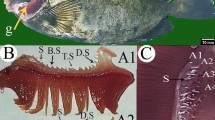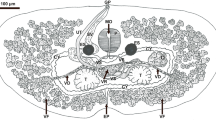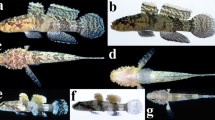Abstract
In this paper, we have described for the first time a semiquantitative method to evaluate histopathological damage, taking the degree of Neoechinorhynchus buttnerae attachment to the intestinal wall of the tambaqui (Colossoma macropomum), an important species in Brazilian aquaculture, into account. Twelve specimens of tambaqui were collected from a fish farm. Their bowels were removed and divided into seven morphologically distinct portions according to density and distribution of the parasite studies. Fragments from each fraction were histologically processed and analyzed. There was a clear preference on the part of N. buttnerae for the intermediate regions of the intestinal tube, where the highest densities were recorded. The intensity of damage to the host, estimated by calculating the Histopathological Alteration Index (HAI), showed severe and irreversible changes only where the parasite had its proboscis penetrated into the intestine wall.





Similar content being viewed by others
References
Amin OM (1987) Acanthocephala from lake fishes in Wisconsin: ecology and host relationships of Pomphorhynchus bulbocolli (Pomphorhynchidae). J Parasitol 73(2):278–289
Amin OM (2013) Classification of the Acanthocephala. Folia Parasitol (Praha) 60(4):273–305
Amin OM, Heckmann RA, Zargar UR (2017) Description of a new quadrigyrid acanthocephalan from Kashmir, with notes on metal analysis and histopathology, and a key to species of the subgenus Acanthosentis from the Indian subcontinent. J Parasitol 103(5):458–470
Bayoumy ME, Abd El-Hady OK, Osman HAM (2006) Site adaptations of Acanthogyrus (Acanthosentis) tilapiae: observations through light and scanning electron microscopy. J Vet Sci 7(4):339–342
Bosi G, Dezfuli BS (2015) Responses of Squalius cephalus intestinal mucous cells to Pomphorhynchus laevis. Parasitol Int 64(2):167–172
Brown AF (1987) Anatomical variability and secondary sexual characteristics in Pomphorhynchus laevis (Müller, 1776) (Acanthocephala). Syst Parasitol 9:213–219
Bush AO, Lafferty KD, Lotz JM, Shostak AW (1997) Parasitology meets ecology on its own terms: Margolis et al. revisited. J Parasitol 83(4):575–583
Caspary WF (1992) Physiology and pathophysiology of intestinal absorption. Am J Clin Nutr 55:299–308
Chagas EC, Maciel PO, Aquino-Pereira SL (2015) Infecções por acantocéfalos: um problema para a produção de peixes. In: Tavares-Dias M, Mariano WS (eds) Aquicultura no Brasil: novas perspectivas. Editora Pedro e João, São Carlos, pp 305–328
Crompton DWT (1973) The sites occupied by some parasitic helminths in the alimentary tract of vertebrates. Biol Rev 48(1):27–83
Dalfovo MS, Lana RA, Silveira A (2008) Métodos quantitativos e qualitativos: um resgate teórico. Revista Interdisciplinar Científica Aplicada 2(4):01–13
De Almeida LC, Lundstedt LM, Moraes G (2006) Digestive enzyme responses of tambaqui (Colossoma macropomum) fed on different levels of protein and lipid. Aquac Nutr 12(6):443–450
De Almeida LC, Avilez IM, Honorato CA, Hori TSF, Moraes G (2011) Growth and metabolic responses of tambaqui (Colossoma macropomum) fed different levels of protein and lipid. Aquac Nutr 17(2):e253–e262
Dezfuli BS, Giari L, Simoni E, Bosi G, Manera M (2002) Histopathology, immunohistochemistry and ultrastructure of the intestine of Leuciscus cephalus (L.) naturally infected with Pomphorhynchus laevis (Acanthocephala). J Fish Dis 25(1):7–14
Dezfuli BS, Giari L, Lui A, Squerzanti S, Castaldelli G, Shinn AP, Manera M, Lorenzoni M (2012) Proliferative cell nuclear antigen (PCNA) expression in the intestine of Salmo trutta trutta naturally infected with an acanthocephalan. Parasit Vectors 5:198
Dezfuli BS, Castaldelli G, Giari L (2017) Histopathological and ultrastructural assessment of two mugilid species infected with myxozoans and helminths. J Fish Dis 00:1–9
Gomes LC, Simões LN, Araújo-Lima CARM (2010) Tambaqui (Colossoma macropomum). In: Baldisserotto B, Gomes LC (eds) Espécies nativas para piscicultura no Brasil, 2nd edn. Editora UFSM, Santa Maria, pp 175–204
Grey AJ, Hayunga EG (1980) Evidence for alternative site selection by Glaridacris laruei (Cestoidea: Caryophyllidea) as a result of interspecific competition. J Parasitol 66(2):371–372
Hakim Y, Harpaz S, Uni Z (2009) Expression of brush border enzymes and transporters in the intestine of European sea bass (Dicentrarchus labrax) following feed deprivation. Aquaculture 290:110–115
Harpaz S, Uni Z (1999) Activity of intestinal mucosal brush border membrane enzymes in relation to the feeding habits of three aquaculture fish species. Comp Biochem Physiol 124:155–160
Harpaz S, Hakim Y, Slosman T, Eroldogan OT (2005) Effects of adding salt to the diet of Asian sea bass Lates calcarifer reared in fresh or salt water recirculating tanks, on growth and brush border enzyme activity. Aquaculture 248:315–324
Hassanine RM, Al-Jahdali MO (2007) Ecological comments on the intestinal helminths of the rabbitfish Siganus rivulatus (Teleostei, Siganidae) from the northern Red Sea. Acta Parasitol 52(3):278–285
Herlyn H, Taraschewski H (2017) Evolutionary anatomy of the muscular apparatus involved in the anchoring of Acanthocephala to the intestinal wall of their vertebrate hosts. Parasitol Res 116(4):1207–1225
Herlyn H, Piskurek O, Schmitz J, Ehlers U, Zischler H (2003) The syndermatan phylogeny and the evolution of acanthocephalan endoparasitism as inferred from 18S rDNA sequences. Mol Phylogenet Evol 26(1):155–164
Jerônimo GT, Pádua SB, Belo MAA, Chagas EC, Taboga SR, Maciel PO, Martins ML (2017) Neoechinorhynchus buttnerae (Acanthocephala) infection in farmed Colossoma macropomum: a pathological approach. Aquaculture 469:124–127
Kennedy CR (2006) Ecology of Acanthocephala. Cambridge University Press, Cambridge, p 249
Kim SR, Lee JS, Kim JH, Oh MJ, Kim CS, Park MA, Park JJ (2011) Fine structure of Longicollum pagrosomi (Acanthocephala: Pomphorhynchidae) and intestinal histopathology of the red sea bream, Pagrus major, infected with acanthocephalans. Parasitol Res 109(1):175–184
Lourenço FS (2017) O ciclo de vida de Neoechinorhynchus (Neoechinorhynchus) buttnerae Golvan, 1956 (Eoacanthocephala: Neoechinorhynchidae) parasito do Colossoma macropomum (Cuvier, 1818) (Characiformes: Characidae) da Amazônia brasileira. Dissertação de mestrado. Pós-graduação em Biologia de Água Doce e Pesca Interior, Manaus-AM
Malta JCO, Gomes ALS, Andrade SMS, Varella AMB (2001) Infestações maciças por acantocéfalos, Neoechinorhynchus buttnerae Golvan, 1956, (Eoacanthocephala: Neoechinorhynchidae) em tambaquis jovens Colossoma macropomum (Cuvier, 1818) cultivados na Amazônia Central. Acta Amazon 31(1):133–143
Martins ML, Fujimoto RY, Andrade PM, Tavares Dias M (2000) Recent studies on Neoechinorhynchus curemai Noronha, 1973 (Acanthocephala:Neoechinorhynchidae) in Prochilodus lineatus, Valenciennes, 1836 from Volta Grande Reservoir, MG, Brazil. Braz J Biol 60(4):673–682
Martins ML, Moraes FR, Fujimoto RY, Onaka EM, Quintana CIF (2001) Prevalence and histopathology of Neoechinorhynchus curemai Noronha, 1973 (Acanthocephala: Neoechinorhynchidae) in Prochilodus lineatus Valenciennes, 1836 from Volta Grande Reservoir, MG, Brazil. Braz J Biol 61(3):517–522
Matos LV, Oliveira MIB, Gomes ALS, Silva GS (2017) Morphological and histochemical changes associated with massive infection by Neoechinorhynchus buttnerae (Acanthocephala: Neoechinorhynchidae) in the farmed freshwater fish Colossoma macropomum Cuvier, 1818 from the Amazon State, Brazil. Parasitol Res 116:1029–1037. https://doi.org/10.1007/s00436-017-5384-3
Melo FTV, Rodrigues RAR, Giese EG, Gardner SL, Santos JN (2014) Histopathologic aspects in Plagioscion squamosissimus (HECKEL, 1940) induced by Neoechinorhynchus veropesoi, metacestodes and anisakidae juveniles. Braz J Vet Parasitol 23(2):224–230
Near TJ, Garey JR, Nadler SA (1998) Phylogenetic relationships of the acanthocephalan inferred from 18s ribosomal DNA sequences. Mol Phylogenet Evol 10(3):287–298
Neto AR (2006) Simulação hidrológica na Amazônia: Rio Madeira. Rio de Janeiro: UFRJ. 178p. Tese de Doutorado. COPPE/UFRJ. Engenharia Civil
Nkwengulila G, Miwita C (2004) Spatial distribution of parasites along the gut of the catfish Clarias gariepinus (Burchell, 1822) (Clariidae) from the Mwanza Gulf, Lake Victoria. Tanz J Sci 30(1):63–70
Ogawa K (2015) Diseases of cultured marine fishes caused by Platyhelminthes (Monogenea, Digenea, Cestoda). Parasitology 142(1):178–195. https://doi.org/10.1017/S0031182014000808
Oliveira AM, Silva MNP, Almeida-Val VMF, Val AL (2012) Characterization of fish culture in meso-regions of the Amazonas state, Brazilian Amazon. Rev Colombiana Cienc Anim 4(1):154–162
Poleksic V, Mitrovic-Tutundzic V (1994) Fish gills as a monitor of subletal and chronic effects of pollution. In: Muller R, Lloyd R (eds) Sublethal and chronic effects of pollutants on freshwater fish. Blacwell Sci, Apud RIGOLIN, Cambridge, pp 339–352
Ross MH, Pawlina W (2016) Histologia: texto e atlas em correlação com a biologia celular e molecular, 7th edn. Guanabara Koogan, Rio de Janeiro
Rotta MA (2003) Aspectos Gerais da Fisiologia e Estrutura do Sistema Digestivo dos Peixes Relacionados à Piscicultura. Embrapa Pantanal, Corumbá, MS. ISSN 1517-1973
Sanil NK, Asokan PK, John L, Vijayan KK (2011) Pathological manifestations of the acanthocephalan parasite, Tenuiproboscis sp. in the mangrove red snapper (Lutjanus argentimaculatus) (Forsskål, 1775), a candidate species for aquaculture from Southern India. Aquaculture 310:259–266
Silva RZ, Pereira JJ, Cousin JCB (2014) Histological patterns of the intestinal attachment of Corynosoma australe (Acanthocephala: Polymorphidae) in Arctocephalus australis (Mammalia: Pinnipedia). J Parasit Dis 38(4):410–416
Soler-Jiménez LC, Paredes-Trujillo AI, Vidal-Martínez VM (2017) Helminth parasites of finfish commercial aquaculture in Latin America. J Helminthol 91(2):110–136
Taraschewski H (2000) Host-parasite interactions in Acanthocephala: a morphological approach. Adv Parasitol 46:1–179
Tibaldi E, Hakim Y, Uni Z, Tulli F, de Francesco M, Luzzana U, Harpaz S (2006) Effects of the partial substitution of dietary fish meal by differently processed soybean meals on growth performance, nutrient digestibility and activity of intestinal brush border enzymes in the European sea bass (Dicentrarchus labrax). Aquaculture 261(1):182–193
Uglem CL, Read CP (1973) Moniliformis dubius: uptake of leucine and alanine by adults. Exp Parasitol 34(1):148–153
Unger P, Palm HW (2017) Parasite risk of maricultured rainbow trout (Oncorhynchus mykiss Walbaum, 1792) in the Western Baltic Sea, Germany. Aquac Int 25:975–989. https://doi.org/10.1007/s10499-016-0096-8
Violante-González J, Villalba-Vásquez PJ, Monks S, García-Ibáñez S, Rojas-Herrera AA, Flores-Garza R (2016) Reproductive traits of the acanthocephalan Neoechinorhynchus brentnickoli in the definitive host. Invertebr Biol 136(1):5–14
Author information
Authors and Affiliations
Corresponding author
Rights and permissions
About this article
Cite this article
Aguiar, L.S., de Oliveira, M.I.B., de Matos, L.V. et al. Distribution of the acanthocephalan Neoechinorhynchus buttnerae and semiquantitative analysis of histopathological damage in the intestine of tambaqui (Colossoma macropomum). Parasitol Res 117, 1689–1698 (2018). https://doi.org/10.1007/s00436-018-5840-8
Received:
Accepted:
Published:
Issue Date:
DOI: https://doi.org/10.1007/s00436-018-5840-8




